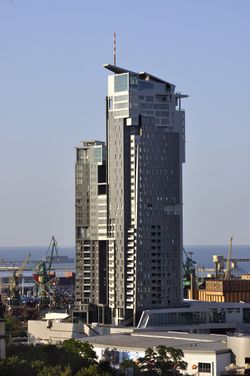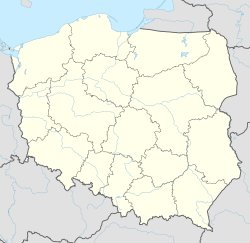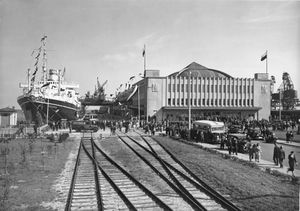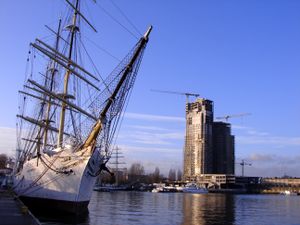گدنيا
Gdynia | |
|---|---|
 | |
| الشعار: Uśmiechnij się, jesteś w Gdyni (Smile, you're in Gdynia) | |
| الإحداثيات: 54°30′N 18°32′E / 54.500°N 18.533°E | |
| Country | Poland |
| Voivodeship | Pomeranian |
| County | city county |
| City rights | February 10, 1926 |
| الأحياء | 22 districts |
| الحكومة | |
| • Mayor | Wojciech Szczurek |
| المساحة | |
| • المدينة | 135 كم² (52 ميل²) |
| أعلى منسوب | 205 m (673 ft) |
| أوطى منسوب | 0 m (0 ft) |
| التعداد (31.03.2014) | |
| • المدينة | 247٬799 |
| • العمرانية | 1٬080٬700 |
| منطقة التوقيت | UTC+1 (CET) |
| • الصيف (التوقيت الصيفي) | UTC+2 (CEST) |
| Postal code | 81-004 to 81-919 |
| مفتاح الهاتف | +48 58 |
| Car plates | GA |
| الموقع الإلكتروني | http://www.gdynia.pl |
Gdynia [ˈɡdɨɲa] (![]() استمع) (ألمانية: Gdingen, كاشوبية: Gdiniô) is a city in the Pomeranian Voivodeship of Poland and a seaport of Gdańsk Bay on the south coast of the Baltic Sea. Located in Kashubia in Eastern Pomerania, Gdynia is part of a conurbation with the spa town of Sopot, the city of Gdańsk and suburban communities, which together form a metropolitan area called the Tricity (Trójmiasto), with a population of over a million people.
استمع) (ألمانية: Gdingen, كاشوبية: Gdiniô) is a city in the Pomeranian Voivodeship of Poland and a seaport of Gdańsk Bay on the south coast of the Baltic Sea. Located in Kashubia in Eastern Pomerania, Gdynia is part of a conurbation with the spa town of Sopot, the city of Gdańsk and suburban communities, which together form a metropolitan area called the Tricity (Trójmiasto), with a population of over a million people.
For centuries, Gdynia remained a small farming and fishing village on the Baltic coast. At the beginning of the 20th-century Gdynia became a seaside resort town and experienced an inflow of tourists. This triggered an increase in local population. After Poland regained its independence in 1918, a decision was made to construct a Polish seaport in Gdynia, between the Free City of Danzig (a semi-autonomous city-state under joint League of Nations and Polish administration) and German Pomerania, making Gdynia the primary economic hub of the Polish Corridor. It was then that the town was given a more cosmopolitan character with modernism being the dominant architectural style and emerged as a city in 1926.
The rapid development of Gdynia was interrupted by the outbreak of World War II. The German troops refrained from deliberate bombing. The newly built port and shipyard were completely destroyed during the war.[1] The population of the city suffered much heavier losses as most of the inhabitants were evicted and expelled. The locals were either displaced to other regions of occupied Poland or sent to Nazi concentration camps throughout Europe. After the war, Gdynia was settled with the former inhabitants of Warsaw and lost cities such as Lviv and Vilnius in the Eastern Borderlands. The city was gradually regenerating itself with its shipyard being rebuilt and expanded. In December 1970 the shipyard workers protest against the increase of prices was bloodily repressed. This greatly contributed to the rise of the Solidarity movement in Gdańsk.
Today the port of Gdynia is a regular stopover on the itinerary of luxurious passenger ships and a new ferry terminal with a civil airport are under realisation. The city won numerous awards in relation to safety, infrastructure, quality of life and a rich variety of tourist attractions. In 2013 Gdynia was ranked as Poland's best city to live in and topped the rankings in the overarching category of general quality of life.[2] Gdynia is also highly noted for its access to education. There are prestigious universities such as the Polish Naval Academy nearby.
Gdynia hosts the Gdynia Film Festival, the main Polish film festival, and was the venue for the International Random Film Festival in 2014.
. . . . . . . . . . . . . . . . . . . . . . . . . . . . . . . . . . . . . . . . . . . . . . . . . . . . . . . . . . . . . . . . . . . . . . . . . . . . . . . . . . . . . . . . . . . . . . . . . . . . . . . . . . . . . . . . . . . . . . . . . . . . . . . . . . . . . . . . . . . . . . . . . . . . . . . . . . . . . . . . . . . . . . . .
Geography
Population and area
| Year | Inhabitants | Area |
|---|---|---|
| 1870 | 1,200 | |
| 1920 | 1,300 | |
| 1926 | 12,000 | 6 km² |
| 1939 | 127,000 | 66 km² |
| 1945 | 70,000 | 66 km² |
| 1960 | 150,200 | 73 km² |
| 1970 | 191,500 | 75 km² |
| 1975 | 221,100 | 134 km² |
| 1980 | 236,400 | 134 km² |
| 1990 | 251,500 | 136 km² |
| 1994 | 252,000 | 136 km² |
| 1995 | 251,400 | 136 km² |
| 2000 | 255,420 | 135.49 square kilometres (52.31 sq mi) (after GUS – Central Statistical Office in Warsaw) |
| 2009 | 248,889 | 136,72 km² |
Climate
The climate of Gdynia is an oceanic climate owing to its position of the Baltic sea, which moderates the temperatures, compared to the interior of Poland. The climate is cool throughout the year and there is a somewhat uniform precipitation throughout the year. Typical of Northern Europe, there is little sunshine during the year.
| بيانات مناخ Gdynia (1976-2010) | |||||||||||||
|---|---|---|---|---|---|---|---|---|---|---|---|---|---|
| الشهر | يناير | فبراير | مارس | أبريل | مايو | يونيو | يوليو | أغسطس | سبتمبر | اكتوبر | نوفمبر | ديسمبر | العام |
| العظمى القياسية °س (°ف) | 13.7 (56.7) |
11.2 (52.2) |
16.0 (60.8) |
24.8 (76.6) |
30.2 (86.4) |
32.1 (89.8) |
34.7 (94.5) |
29.3 (84.7) |
28.5 (83.3) |
22.1 (71.8) |
15.2 (59.4) |
14.1 (57.4) |
34٫7 (94٫5) |
| العظمى المتوسطة °س (°ف) | 2.0 (35.6) |
2.8 (37) |
6.2 (43.2) |
11.6 (52.9) |
16.8 (62.2) |
20.4 (68.7) |
22.7 (72.9) |
22.5 (72.5) |
18.4 (65.1) |
12.2 (54) |
7.6 (45.7) |
4.3 (39.7) |
12٫29 (54٫13) |
| المتوسط اليومي °س (°ف) | -0.6 (30.9) |
0.35 (32.63) |
2.25 (36.05) |
7.65 (45.77) |
12.0 (53.6) |
15.9 (60.6) |
18.75 (65.75) |
18.5 (65.3) |
15.1 (59.2) |
9.25 (48.65) |
5.65 (42.17) |
2.45 (36.41) |
8٫94 (48٫09) |
| الصغرى المتوسطة °س (°ف) | -3.2 (26.2) |
-2.1 (28.2) |
-1.7 (28.9) |
3.7 (38.7) |
7.2 (45) |
11.4 (52.5) |
14.8 (58.6) |
14.5 (58.1) |
11.8 (53.2) |
6.3 (43.3) |
3.7 (38.7) |
0.6 (33.1) |
5٫58 (42٫05) |
| الصغرى القياسية °س (°ف) | -21.2 (-6.2) |
-12.6 (9.3) |
-13.9 (7) |
-4.6 (23.7) |
-2.3 (27.9) |
4.7 (40.5) |
9.2 (48.6) |
7.7 (45.9) |
-4.6 (23.7) |
-3.8 (25.2) |
-5.2 (22.6) |
-14.5 (5.9) |
−21٫2 (−6٫2) |
| هطول mm (inches) | 46.6 (1.835) |
40.6 (1.598) |
47.7 (1.878) |
36.6 (1.441) |
60.1 (2.366) |
59.6 (2.346) |
72.5 (2.854) |
74.9 (2.949) |
71.2 (2.803) |
67.8 (2.669) |
61.2 (2.409) |
57.8 (2.276) |
696٫6 (27٫425) |
| % Humidity | 82 | 86 | 79 | 69 | 63 | 69 | 71 | 72 | 82 | 83 | 84 | 87 | 77٫3 |
| Avg. rainy days | 15 | 11 | 13 | 13 | 16 | 15 | 16 | 17 | 14 | 18 | 19 | 16 | 183 |
| Avg. snowy days | 11 | 13 | 10 | 2 | 0 | 0 | 0 | 0 | 0 | 1 | 6 | 7 | 50 |
| Source: my weather2[3] | |||||||||||||
International relations
Twin towns — sister cities
. . . . . . . . . . . . . . . . . . . . . . . . . . . . . . . . . . . . . . . . . . . . . . . . . . . . . . . . . . . . . . . . . . . . . . . . . . . . . . . . . . . . . . . . . . . . . . . . . . . . . . . . . . . . . . . . . . . . . . . . . . . . . . . . . . . . . . . . . . . . . . . . . . . . . . . . . . . . . . . . . . . . . . . .
انظر أيضاً
References
- ^ "Gdynia turystyczna". Retrieved 29 November 2016.
- ^ "Gdynia rated Poland's best city". Retrieved 29 November 2016.
- ^ "my weather2". Weather 2. Retrieved 31 March 2015.
- ^ أ ب ت ث ج ح خ د ذ ر ز س ش ص ض P.C., Net. "Gdynia - International Gdynia - International co-operation of Gdynia". www.gdynia.pl. Archived from the original on 2016-10-19.
{{cite web}}: Unknown parameter|deadurl=ignored (|url-status=suggested) (help) - ^ "Aalborg Twin Towns". Europeprize.net. Archived from the original on 7 September 2013. Retrieved 19 August 2013.
{{cite web}}: Unknown parameter|deadurl=ignored (|url-status=suggested) (help) - ^ "Aalborg Kommune – Venskabsbyer". Web.archive.org. 2007-11-14. Archived from the original on 2007-11-14. Retrieved 2009-07-26.
- ^ "Города-партнёры" (in Russian). Kaliningrad City Hall. Archived from the original on April 22, 2009. Retrieved 2008-12-08.
{{cite web}}: Unknown parameter|deadurl=ignored (|url-status=suggested) (help)CS1 maint: unrecognized language (link) - ^ Luhn, Alec (20 November 2011). "Kaliningrad". The Moscow Times. Retrieved 26 February 2016.
- ^ "Twin cities of Kiel". kiel.de (in German).
{{cite web}}: CS1 maint: unrecognized language (link) - ^ Hassinen, Raino. "Kotka - International co-operation: Twin Cities". City of Kotka. Retrieved 2013-10-22.
- ^ "Plymouth – Town Twinning". Plymouth City Council. Retrieved 2013-07-14.
- ^ "Seattle, Washington Sister Cities". Sister Cities International. Archived from the original on July 17, 2014. Retrieved July 17, 2014.
{{cite web}}: Unknown parameter|deadurl=ignored (|url-status=suggested) (help) - ^ "珠海与波兰格丁尼亚市结为友好城市 加强交流深化经贸合作".
Further reading
- (ed.) R. Wapiński, Dzieje Gdyni, Gdańsk 1980
- (ed.). S. Gierszewski, Gdynia, Gdańsk 1968
- Gdynia, in: Pomorze Gdańskie, nr 5, Gdańsk 1968
- J. Borowik, Gdynia, port Rzeczypospolitej, Toruń 1934
- B. Kasprowicz, Problemy ekonomiczne budowy i eksploatacji portu w Gdyni w latach 1920–1939, Zapiski Historyczne, nr 1-3/1956
- M. Widernik, Główne problemy gospodarczo-społeczne miasta Gdyni w latach 1926–1939., Gdańsk 1970
- (ed.) A. Bukowski, Gdynia. Sylwetki ludzi, oświata i nauka, literatura i kultura, Gdańsk 1979
- Gminy województwa gdańskiego, Gdańsk 1995
- H. Górnowicz, Z. Brocki, Nazwy miast Pomorza Gdańskiego, Wrocław 1978
- Gerard Labuda (ed.), Historia Pomorza, vol. I-IV, Poznań 1969–2003
- (ed.) W. Odyniec, Dzieje Pomorza Nadwiślańskiego od VII wieku do 1945 roku, Gdańsk 1978
- L. Bądkowski, Pomorska myśl polityczna, Gdańsk 1990
- L. Bądkowski, W. Samp, Poczet książąt Pomorza Gdańskiego, Gdańsk 1974
- B. Śliwiński, Poczet książąt gdańskich, Gdańsk 1997
- Józef Spors, Podziały administracyjne Pomorza Gdańskiego i Sławieńsko-Słupskiego od XII do początków XIV w, Słupsk 1983
- M. Latoszek, Pomorze. Zagadnienia etniczno-regionalne, Gdańsk 1996
- B. Bojarska, Eksterminacja inteligencji polskiej na Pomorzu Gdańskim (wrzesień-grudzień 1939), Poznań 1972
- K. Ciechanowski, Ruch oporu na Pomorzu Gdańskim 1939–1945., Warszawa 1972
External links
- CS1 errors: unsupported parameter
- Short description is different from Wikidata
- Pages using infobox settlement with possible motto list
- Articles containing ألمانية-language text
- Articles containing كاشوبية-language text
- Articles with hatnote templates targeting a nonexistent page
- Coordinates on Wikidata
- Gdynia
- Planned cities in Poland
- Port cities and towns in Poland
- موانئ بحر البلطيق
- 1926 in Poland
- المقاطعات المدن في پولندا
- Cities and towns in Pomeranian Voivodeship
- Pomeranian Voivodeship (1919–39)
- Marinas in Poland
- UFO sightings








